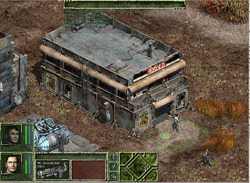RPG Codex Review: BloodNet (1993)
RPG Codex Review: BloodNet (1993)
Review - posted by Crooked Bee on Wed 29 January 2014, 20:50:46
Tags: BloodNet; MicroProseBloodNet is a 1993 adventure/RPG hybrid that has been recently re-released on GOG. In this review, community member Satan in the Suburbs attemps to find out if the game is worth your hard-earned $5.99.
According to him, the answer is a no:
Read the review in full: RPG Codex Review: BloodNet
According to him, the answer is a no:
Most characters are completely one dimensional: instead of complex personalities with more than one flavor, more than one outlook, most characters have one personality-tick that's driven into the ground. The exceptions are the characters who are so bland that there's nothing to comment on. There are also some references to real people in-game (ex. Kafka, Nietzsche, Orwell, Sterling), but these references are little more than name-drops. Some of them don't connect with the game at all, as if the writers are just trying to impress you.
Any writer worth the title knows that character development is what makes characters have life. In this area, BloodNet falls completely on its face. There is absolutely no character development to be found in BloodNet. Every character is exactly the same at the beginning of the game as they are in the end. Any obstacle in BloodNet exists solely for the sake of gameplay, as opposed to an obstacle that, when overcome, changes a character's outlook. Each character arc is completely flat.
[...] The combat system is by far the weakest aspect of the game, and it's a shame since there are many mandatory fights. The interface is clunky and unintuitive, time consuming when you have to give orders to every party member and stop combat with the escape button, and ultimately just not fun. There is no tutorial for anything, so you'll have to read the manual (which includes false information) to understand exactly what to do. Combat is turn-based, and it comes in two types: descriptive and quick. Quick combat lets the computer make decisions for you, which will invariably lead to the death of your entire party and force you to reload the game. Descriptive combat is where you make the decisions. In this mode, however, combat can become rocket tag, if you know the trick. Most enemies can die in one or two hits, provided that they're not wearing an armor type that absorbs the specific type of damage you're dealing, that you're targeting their chests, and that you're using the right weapon. There are a multitude of weapons in the game, but the one that you'll probably use the most throughout the game is one that's in your inventory at the very beginning: the sawed-off shotgun. One hit to the chest is all it takes for most enemies to die. You can target an enemy's limbs, but there's never any reason to do so.
[...] BloodNet is not a good game by any stretch of the imagination. It's likely to give you a major headache with all its faults, forcing you to give up on it midway through when you've triggered one of the many ways to render the game unwinnable. While the cyberpunk aspect of BloodNet is executed well, the vampire aspect of the game seems to be tacked on as little more than a gameplay quirk. However, if you're willing to look past all of its failings, you may find something to like. BloodNet is a game with some good ideas, but with an absolutely terrible execution.
Any writer worth the title knows that character development is what makes characters have life. In this area, BloodNet falls completely on its face. There is absolutely no character development to be found in BloodNet. Every character is exactly the same at the beginning of the game as they are in the end. Any obstacle in BloodNet exists solely for the sake of gameplay, as opposed to an obstacle that, when overcome, changes a character's outlook. Each character arc is completely flat.
[...] The combat system is by far the weakest aspect of the game, and it's a shame since there are many mandatory fights. The interface is clunky and unintuitive, time consuming when you have to give orders to every party member and stop combat with the escape button, and ultimately just not fun. There is no tutorial for anything, so you'll have to read the manual (which includes false information) to understand exactly what to do. Combat is turn-based, and it comes in two types: descriptive and quick. Quick combat lets the computer make decisions for you, which will invariably lead to the death of your entire party and force you to reload the game. Descriptive combat is where you make the decisions. In this mode, however, combat can become rocket tag, if you know the trick. Most enemies can die in one or two hits, provided that they're not wearing an armor type that absorbs the specific type of damage you're dealing, that you're targeting their chests, and that you're using the right weapon. There are a multitude of weapons in the game, but the one that you'll probably use the most throughout the game is one that's in your inventory at the very beginning: the sawed-off shotgun. One hit to the chest is all it takes for most enemies to die. You can target an enemy's limbs, but there's never any reason to do so.
[...] BloodNet is not a good game by any stretch of the imagination. It's likely to give you a major headache with all its faults, forcing you to give up on it midway through when you've triggered one of the many ways to render the game unwinnable. While the cyberpunk aspect of BloodNet is executed well, the vampire aspect of the game seems to be tacked on as little more than a gameplay quirk. However, if you're willing to look past all of its failings, you may find something to like. BloodNet is a game with some good ideas, but with an absolutely terrible execution.
Read the review in full: RPG Codex Review: BloodNet
[Written by Satan in the Suburbs, edited by Infinitron]
BloodNet is a 1993 adventure/RPG hybrid that has been recently re-released on GOG. In this review, Satan in the Suburbs attemps to find out if the game is worth your hard-earned $5.99.

BloodNet is likely to generate interest simply because it's the only game that mixes cyberpunk themes and aesthetics with vampire mythology. However, you should know what you're getting into before you decide to buy it. BloodNet is not a good game. It's chock full of bugs (thankfully nothing game-breaking), has some very obtuse game mechanics, and is very difficult if you don't know exactly what to do at what time. Its writing has been praised by some, but I found it to be mostly forgettable. There is good, however, and I will consider both the good and bad in the following paragraphs.
Right away, I will mention that the game mostly consists of reading text, or listening to terrible voice acting with the CD version. You can turn the voice-acting off in the CD version by turning the sound off at the main menu or in the game's menu. You'll miss out on some sound effects, though, and there is no way to get the voice acting at the same time as the text – it's one or the other. If you aren't up for a heavy amount of reading, don't bother with BloodNet.
The Good
The Setting
I feel as if I should start with the reasons why you should play BloodNet, since the reasons not to far outweigh the former. The good news is, if you like the idea of exploring a futuristic cyberpunk city, talking to a variety of inhabitants (for example, bourgeois aristocrats at the Hellfire Club, or gangs of renegade mercenaries scattered around the city), BloodNet will be right up your alley. There are a few problems with this in regards to the game's mechanics, coupled with the fact that much of the dialogue is forgettable, but I will consider those later.
The game's aesthetics really nail down the cyberpunk feeling. Even though the backgrounds are very colorful, you can really feel the oppressive atmosphere of the game's setting, in which Transtech (the megacorporation that runs things in 2094 Manhattan) hoards most everything for itself, leaving most of the city and its citizens to decay and ruin.
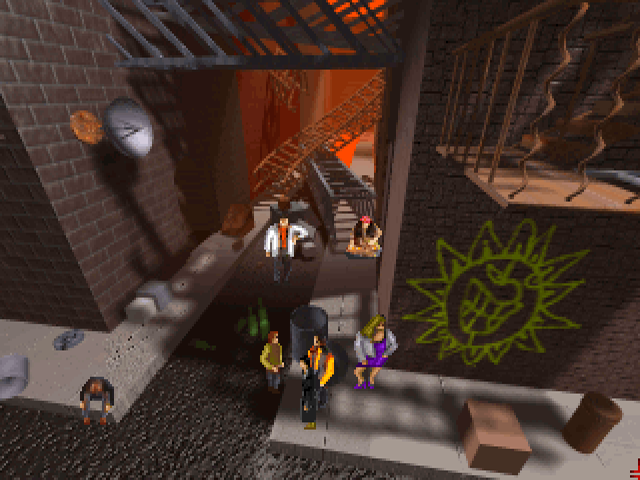
One of the many run-down areas of the city.
The Day/Night Cycle
There is a day and night cycle in the game, and in some locations, different NPCs populate the areas at night than in the day. It's kind of a neat thing for such an old game. Time passes during travel between locations, and during some activities like jury-rigging, but it doesn't pass when walking around a location, talking to NPCs, or being decked into cyberspace.
The Soundtrack*
This is on the condition that you're playing the Amiga version, because the DOS music (even when using general MIDI) is terrible. Most songs are a scrambled mess of early 90's electronic beeps and boops. The Amiga version has a much better soundtrack, and I actually recommend playing the Amiga version over either DOS version for this reason. If you do play the DOS version, I recommend turning the music off, via the main menu. For a comparison of the soundtracks, here are three different versions (DOS MIDI, DOS Soundblaster, and Amiga) of the same music being played in the same location:
CD, Floppy, and Amiga Differences
You might be wondering if there are any other differences between the Amiga and DOS versions. They are, for the most part, identical, aside from the fact that the Amiga version does not include the features that the DOS CD version includes: optional speech rather than text, small pictures of each location on the world map, and the occasional 3D video sequence.
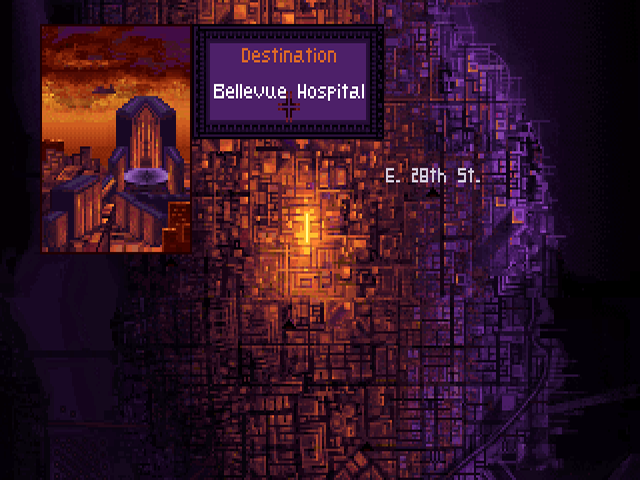
One of the location pictures in the CD version. In the Amiga and DOS Floppy versions, there is only the location listed.
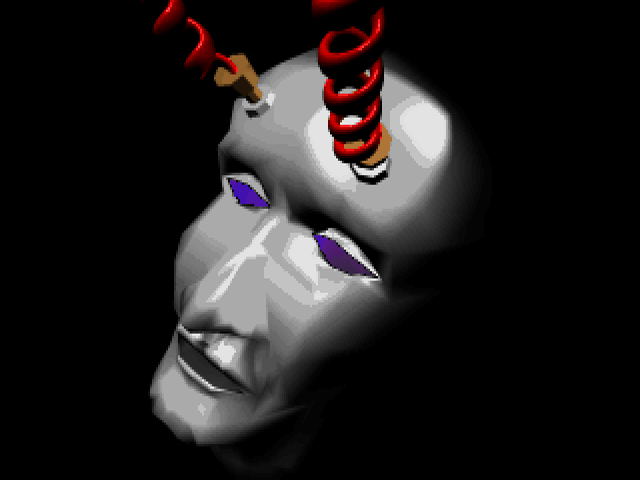
One of the very few 3D video sequences. BloodNet was released in 1993, so don't expect anything mind-blowing by today's standards.
As I mentioned before, the voice acting is terrible. Listen for yourself, to a clip that's representative of the standard quality of voice acting in BloodNet:
The Bad
The Writing
I found that, with the exception of some minor characters that are so ridiculous they make you laugh (for example, there's a character named Words Blanque, who defines words with dictionary definitions as he uses them), the game's writing is just bland and forgettable.
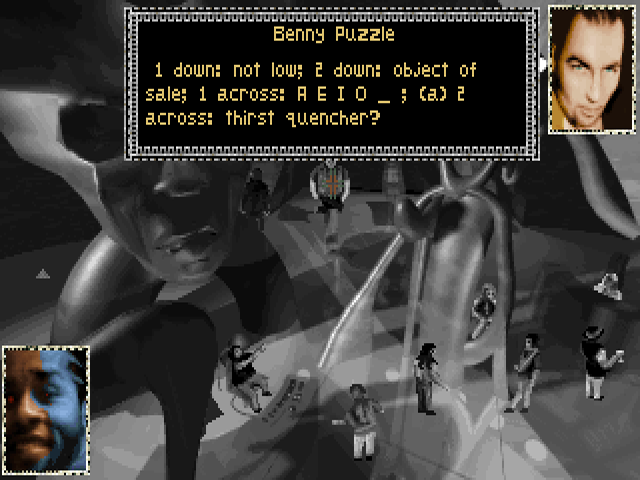
Another ridiculous character, Benny Puzzle, speaks in crossword puzzles. Here, he's offering to buy the player a drink.
Most characters are completely one dimensional: instead of complex personalities with more than one flavor, more than one outlook, most characters have one personality-tick that's driven into the ground. The exceptions are the characters who are so bland that there's nothing to comment on. There are also some references to real people in-game (ex. Kafka, Nietzsche, Orwell, Sterling), but these references are little more than name-drops. Some of them don't connect with the game at all, as if the writers are just trying to impress you.
Any writer worth the title knows that character development is what makes characters have life. In this area, BloodNet falls completely on its face. There is absolutely no character development to be found in BloodNet. Every character is exactly the same at the beginning of the game as they are in the end. Any obstacle in BloodNet exists solely for the sake of gameplay, as opposed to an obstacle that, when overcome, changes a character's outlook. Each character arc is completely flat.
The Story
BloodNet's main story has been praised as being well-written, which, in my view, is the opposite of the truth. Its premise sounds good: The player, as Ransom Stark, must find a cure for vampirism before the only thing keeping him partially human, his neural implant, fails. The problem is that, over the span of the entire game, the main plot comes at you in very rare chunks, as opposed to a smooth progression where details are progressively revealed to you. Take, for example, the fact that the main antagonist, Abraham Van Helsing, explains exactly what his plans are, how the main character fits into them, the lengths he went through, the means he will use to achieve his goals (something called Incubus, which is “the ultimate icebreaker”), and more, before the game's introduction is even finished. In addition to this, the ending is terrible - an unexplained plot-twist coupled with a cliffhanger that never gets resolved. Supposedly a sequel called BloodNet 2000 was in the works, but nothing was ever released.
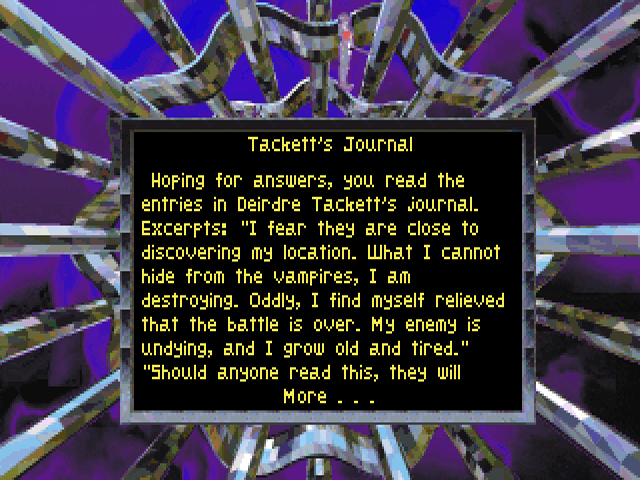
plotdump.txt
The Sprites
Earlier I praised the aesthetics, and they are good, but a big problem with the graphics is that characters are just small messes of pixels compared to the big backgrounds. Items are nondescript collections of gray pixels. They don't look good.
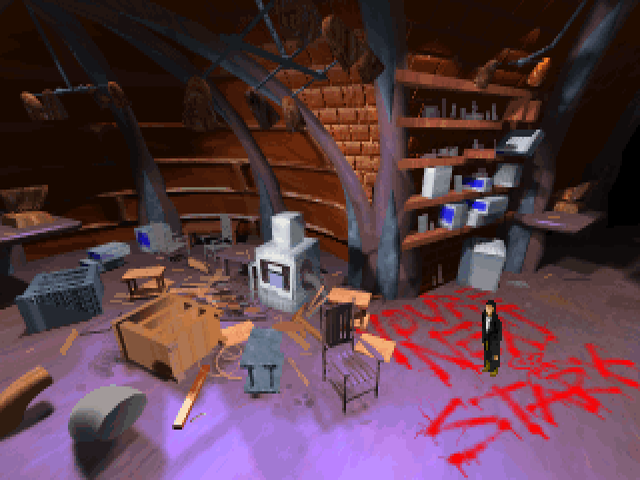
Notice how Stark is smaller than the chair in the background.
The User Interface
The UI is the worst I've ever used in a game. It takes some time to figure out, and it's not intuitive in the slightest. It's very frustrating for a new player. For example, you can spend hours clicking around the screen trying to bring up the inventory screen, but it can only be brought up by pressing 1 on the keyboard, bringing up the character sheet, then by pressing Inventory. What makes it worse is that what each button does changes depending on context. If you're decked into cyberspace, none of the previous buttons that controlled the UI do anything. Suddenly, right-clicking the mouse is the only way to bring up the menu.
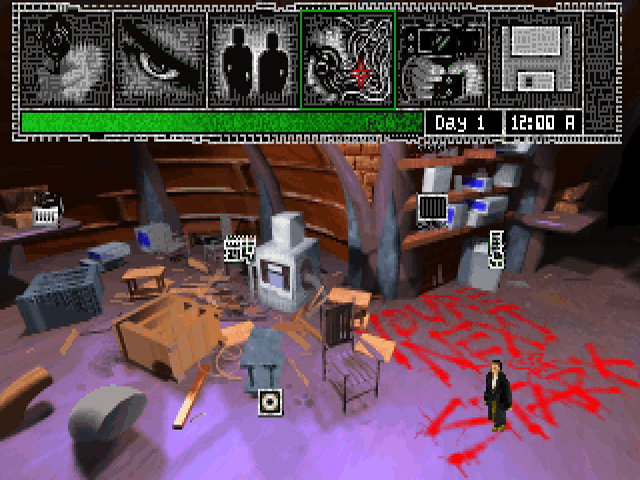
The Stat System
The stat system, coupled with character creation, must be written about as one of the biggest failures of BloodNet. Some are quick to categorize BloodNet as an Adventure/RPG hybrid, but, at best, it's correctly classified as a point & click adventure with RPG elements. Of these elements, the biggest one is the stat system, and it's a complete mess. I could list every stat and try to explain its problems, but the fact is that exactly what most of the stats do is a mystery. The manual doesn't help, either, since a good portion of its information is simply wrong. I have a hunch that it was written before they finished the game, and reflects ideas they had that were never implemented. In regards to the stats, the manual is so vague about them that you're never really sure what each stat does. One of them, Blades, doesn't even appear in the manual. There are 27 stats in total. Some of them have their uses (strength, endurance, agility), but you're never exactly sure what each stat governs. You can get ideas from in-game text here and there (agility helps dodge vampire bites, for example), but it's not enough information. It doesn't help that each stat goes from a range of 1 to over 200 (one character you can recruit has a strength score of 211.) Some of are completely useless (stealth, pickpocket, intelligence, fast-talk, courage, I could go on but you get the idea). Some skills are just not implemented in-game at all (pickpocket, leadership). The skill checks that exist in-game are seemingly binary: either you have enough (exactly how much is never shown) or you don't. There's also some overlap in skills, for example, in the manual, it's written that Faith affects your character's skill in using soul blades. So what does the Blades skill do? There are no other blades in the game (other than blessed soul blades), so how can you be sure? As a last note on the stat system, some stats you have will seemingly increase at random by one or two points throughout the game. There is one way to increase stats by attaching artificial limbs to your character, but the cost (time and money) outweighs the benefits (you're never sure which stat will increase without testing and reloading, and even then it's only by 10-20 points. In some cases, I've attached an artificial arm, which increased endurance, but decreased fast-talk and bargaining for some unknown reason.
Character Creation
Even more disappointing than the stat system is character creation. There are two methods of character creation: manual generation and quick generation. Quick generation spits a character out at you at random, only allowing you to allocate a small amount of bonus points and select a portrait. I don't recommend ever doing it. Manual generation poses a series of 12 questions for you to answer. I'm going to quote the manual for an explanation of this:
In hindsight, answering these questions is the most fun you'll have while playing BloodNet.
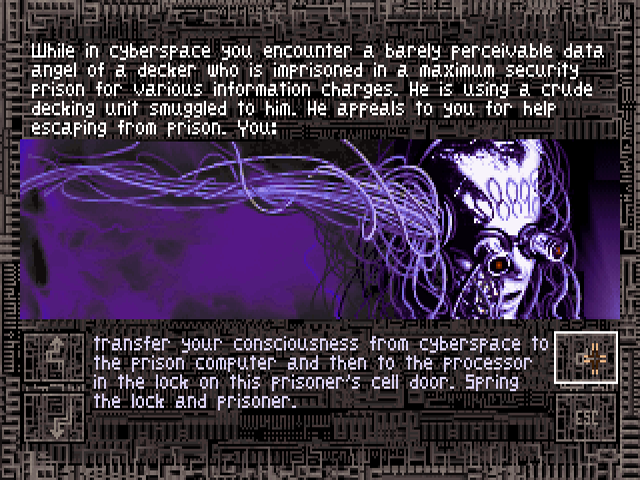
The biggest problem with character creation is that your skills will almost always turn out to be worse than every other party member's. I'm almost certain that they were meant to be multiplied by a modifier, but as it stands, unless you go for a straight-up mercenary (which is highly recommended, since it's required that your character survive every fight), every character you can make will be the worst in the game. If you choose, like I did the first time, to be a decker, your skills will be outmatched completely by almost any companion you can pick up right at the beginning of the game, including even the ones who join you for free. There's actually a homeless, drug-addicted kid living in Central Park named Dodger that will have better stats than you. It's laughable.
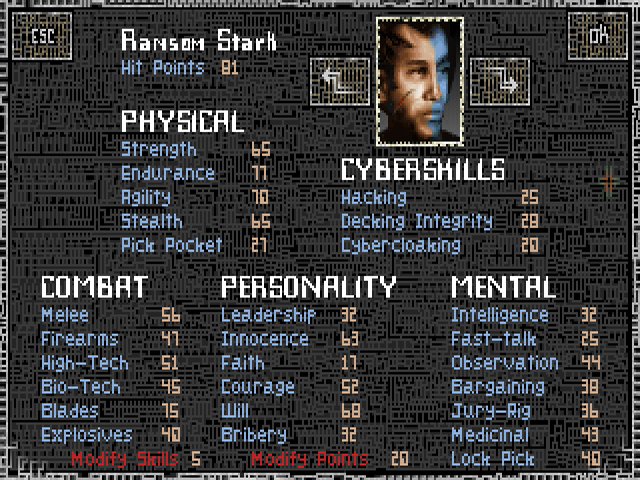
Stark after a balanced character creation. Note how he's uniformly terrible at everything.
The Lack of a Quest Log
BloodNet is a game primarily based around exploring a giant cyberpunk city, collecting quests along the way. An enormous fault with this is that there is no quest log, no journal system, no way of keeping track of which quests you've collected and completed. BloodNet's solution to this is one of the worst ideas I've ever seen in a video game: something called “Dialog Replay”, which you can access with the in-game interface. What this “dialogue replay” is, is just every single conversation you've had with any character listed at random, with nothing but the person's name who you talked to signifying who the conversation was with. If you've had multiple conversations with a character, you'll have multiple instances of their name listed, but with no distinction between them. Funnily enough, the dialogue in the introduction is never included in “dialogue replay”, even though the introduction has information in it that is necessary to complete the game, and that information is not repeated anywhere else. It probably has to do with the fact that the introduction comes before character creation, but still, if you forget that Dierdre Tackett's WELL is called HOPE, you'll never complete the game. It makes you play BloodNet with a pen and sheets of paper at your side, making your own quest log, which is not fun for anyone.
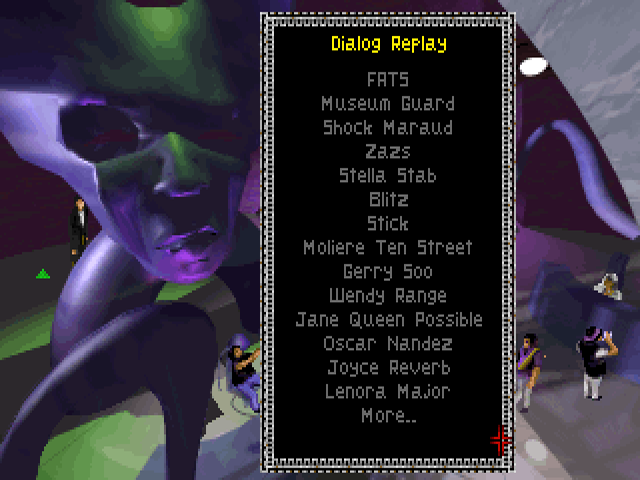
The Extreme Amount of Non-Linearity & Quest Structure
BloodNet is by far the most non-linear game I've ever played. Most locations in the game can be visited at any time, and you'll be picking up many, many side-quests along the way. Unfortunately, you most likely won't be sure which quests lead you toward finishing the game, and which quests are completely optional. What this amounts to is that you'll be moving from location to location, completing small stages in each quest, mostly consiting of picking up items and bringing them to people at different locations, all the while hoping for a payoff that will never come. BloodNet would have benefited greatly from having a more linear structure, both in design and plot-development.
Humanity & Bloodlust
The biggest problem with exploration is not the lack of a quest log, however. It's the fact that the game's own mechanics actively punish you for exploring. In BloodNet, you're on two different time limits: a bloodlust time limit and a humanity time limit. Bloodlust is self-explanatory – as a half-vampire, you still crave blood, and if the bloodlust meter reaches 100%, you'll lose control of your character as he bites a nearby NPC, which can even be a party member, killing them in the process. Losing control and biting someone will lead to most of your party members getting freaked out and leaving the party. If there's no one around to bite, it's game over. As in-game time passes, which happens as you travel between areas, the bloodlust meter rises at a moderately fast rate, and the only ways to lower it are to either drink a vial of blood (only three or four exist in the game), or to bite someone out of your own choice. The problem with the latter is that it kills whichever NPC you bite, and if it was a plot-critical NPC, you've just made the game unwinnable. Biting someone also lowers your humanity, which is the other time limit.
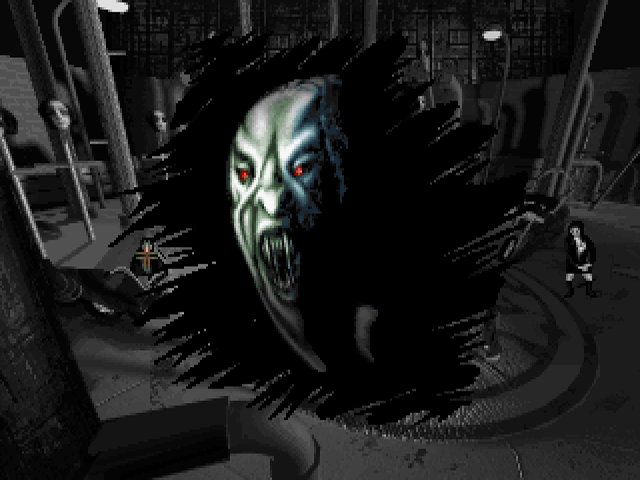
The face of bloodlust
Worse, if you have the sound on, a horrible noise will loop continuously when you have the menu open and a bloodlust score of 75% or over. Listen for yourself:
The humanity time limit is the one that's sure to end the games of most players. You have a humanity bar, starting at 99%, which slowly decreases as time passes. This might not seem so bad, but constantly moving from location to location, picking up quests, never being quite sure what's optional and what's mandatory to do in order to finish the game, this bar goes down fast enough that, if you make it to near the end of the game, you'll be scrambling to finish by avoiding fights and dialogue. Not to mention the impact of biting on your humanity, and also of a few in-game encounters. There is no way to raise your humanity, or stop it from lowering, so you'll just have to restart the game if you find yourself in an unwinnable state.
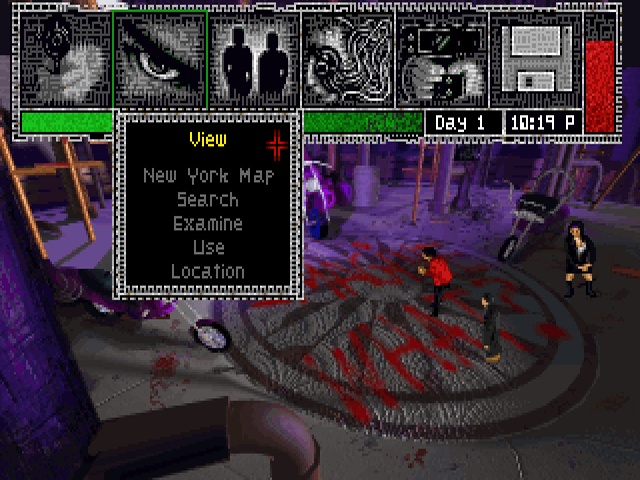
Humanity is represented graphically by the green bar.
Cyberspace
Aside from reality, a realm of exploration exists in BloodNet common to the cyberpunk genre: cyberspace. In addition to the existence of decking units and ICE, the fact that cyberspace is a world of assorted colors and shapes seems ripped straight out of Neuromancer. This may seem interesting, but the problem is that cyberspace is rarely used for much outside of an occasional encounter with another character, and a vehicle for item collection. The formula for cyberspace in BloodNet is for the player to deck in, go to a WELL (illegal data cluster), grab an item, and deck out (deck is used as a verb instead of jacking in). Ultimately, cyberspace is disappointing simply because it's an afterthought. During any trip into cyberspace, any items or encounters to be found can be experienced in just two or three screens. There's no reason to explore the seemingly unlimited general plane simply because there's nothing to be found outside of the first two screens or so. In fact, there is actually a big reason not to explore cyberspace: you can get caught by TransTech security, and if that happens, everything in your decking inventory (items you pick up in cyberspace) is confiscated, with no way to get them back. If you had any plot-critical items, you've just made the game unwinnable. Even worse, you might get trapped inside of a "cage" in cyberspace, with no way to move or deck out. You can actually die in cyberspace if you stay decked in for too long, which is affected by your character's decking integrity score, or your companion's highest score if you have a patch cord in your inventory. The specifics of the formula are never explained.
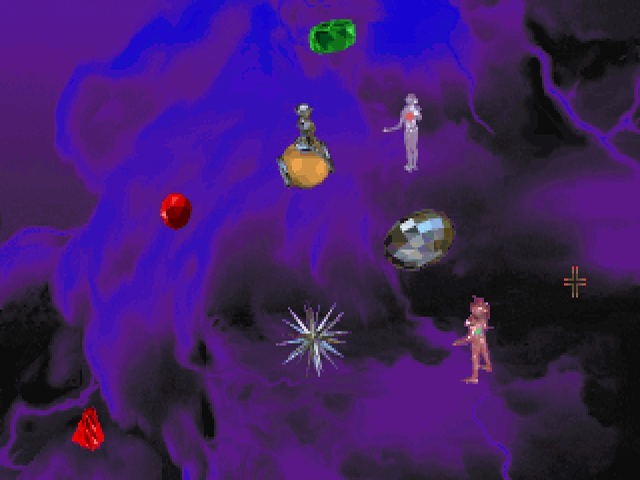
The general plane in cyberspace
Combat
The combat system is by far the weakest aspect of the game, and it's a shame since there are many mandatory fights. The interface is clunky and unintuitive, time consuming when you have to give orders to every party member and stop combat with the escape button, and ultimately just not fun. There is no tutorial for anything, so you'll have to read the manual (which includes false information) to understand exactly what to do. Combat is turn-based, and it comes in two types: descriptive and quick. Quick combat lets the computer make decisions for you, which will invariably lead to the death of your entire party and force you to reload the game. Descriptive combat is where you make the decisions. In this mode, however, combat can become rocket tag, if you know the trick. Most enemies can die in one or two hits, provided that they're not wearing an armor type that absorbs the specific type of damage you're dealing, that you're targeting their chests, and that you're using the right weapon. There are a multitude of weapons in the game, but the one that you'll probably use the most throughout the game is one that's in your inventory at the very beginning: the sawed-off shotgun. One hit to the chest is all it takes for most enemies to die. You can target an enemy's limbs, but there's never any reason to do so.
The game's combat system doesn't really make sense. For example, one enemy might have 110 total hitpoints, but taking out all 44 hitpoints of his torso kills him. It's never explained in the manual. When fighting vampires, the only way to kill them to is pierce their hearts (i.e., target their chests) with either a stake or one of two types of soul blades. A problem with this is that to actually walk up to the vampire (if you're not exactly next to them) takes multiple rounds, and the distance you walk in each round is seemingly random. When you do get there, sometimes your character won't act at all, sometimes enemy vampires will get them in a “bite loop”, where the vampire can continuously paralyze them with biting until they're dead, and even with high combat skills, you'll repeatedly miss. If you do hit them, however, vampires can be killed in one shot. If a party member falls in combat, which can happen in an instant – remember, combat is rocket tag – they're dead for good. If they were plot-critical, you've essentially lost the game without a game over screen. You're walking dead. To conclude, there's nothing good about the game's combat. It's not fun or challenging in a good sense, and can be cheesed if you know how it works. As a side note, the final boss can be killed in one hit, making combat seem even more like a joke.
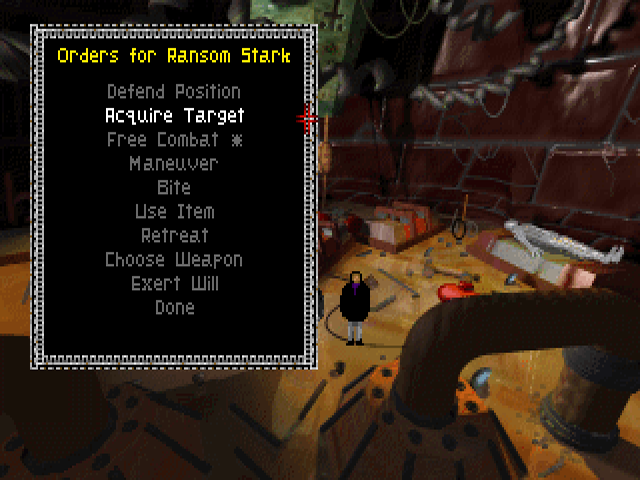
Menu-diving in combat is unnecessarily complicated.
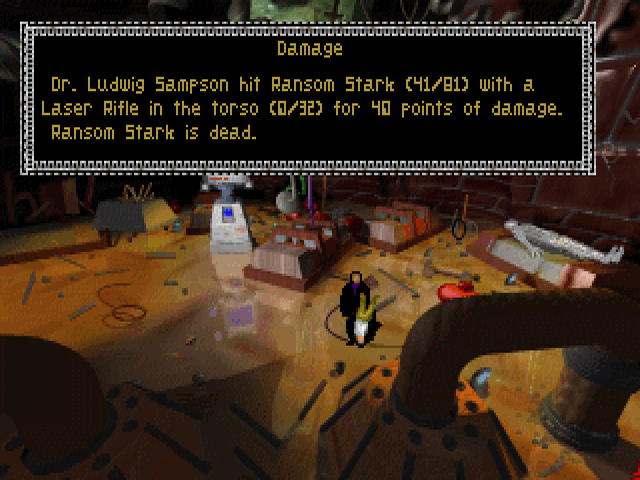
Combat is nonsensical.
Party Dialogue
BloodNet is a party-based game, and there are many party members that can be recruited. Some will join you for free, some will want money, some for items, some will want a quest done, and some will join you as a result of a quest. There are a good variety of possible party members, which is nice, but the problem comes once they're in your party. Specifically, party banter. Some characters, like Max Bax, seem to be very interesting from the little dialogue they offer you before you recruit them. The problem is that many of these characters, including Max Bax, will never say a word again after joining you, making their presence meaningless outside of combat. Silent party members are actually the norm in BloodNet, with the talkative ones being the outliers, the most extreme example being Lash Givens, who always has a comment to give when going to a new place or speaking with someone.
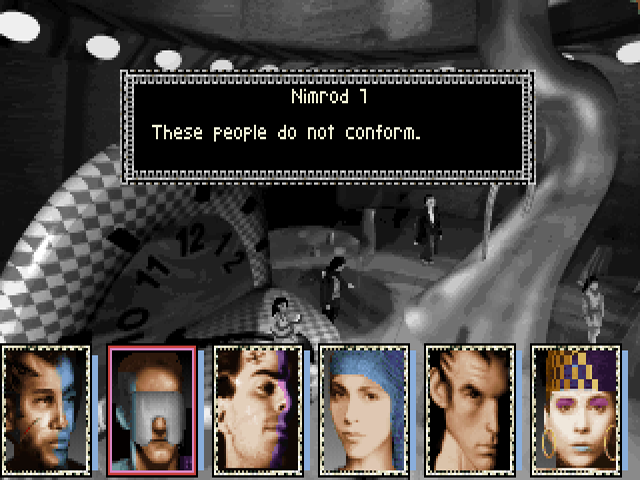
An example of party dialogue
Items
There are many items to find or buy from vendors, but most of them are either useless, or do so little that they're not worth buying. As a result, you'll end the game with a huge amount of money (I ended with 537194 dollars) just because there's nothing to buy. Some items that are required to complete mandatory puzzles in the game are unique, but you won't know that at first glance, so if you've sold them, disassembled them, or didn't pick them up, you're out of luck.
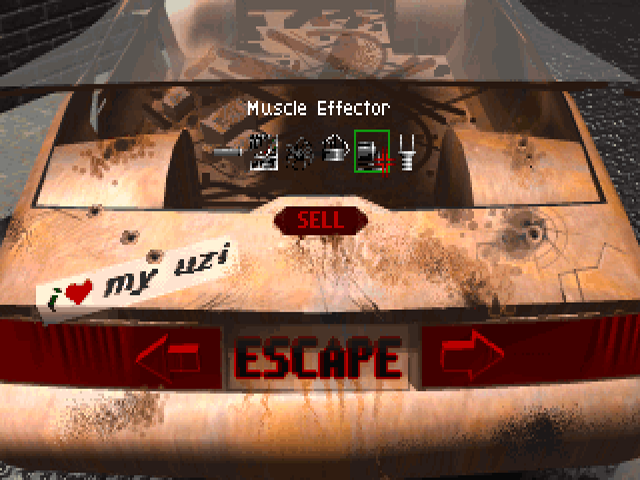
Most of the items in BloodNet are useless.
Jury-Rigging & Buggyness
The jury-rig skill, outside of it being required for some quests, is a failure, because the weapons you can make with it are useless. They have a chance of 'failing' in combat, which happens so often that they're not worth using. They also have a chance of blowing up in your face, and even worse, every item that's listed under jury-rig in the manual, even if you didn't make it, counts as being jury rigged. That cool .44 pistol you picked up from a vendor? Utterly useless. That flamethrower you put together out of some miscellaneous items? Useless. To top it off, every weapon that falls under the category of “Bio-Tech” counts as jury-rigged, not to mention that you have to go to the one cybersurgeon that exists in-game to pay for them to be grafted on your body. Lastly, jury-rigging takes up time, which increases your bloodlust and lowers your humanity. BloodNet is filled to the brim with little bugs like that. There's a high-tech weapon called the “Buzzsaw”, which you can buy from a vendor or find elsewhere, but it's completely bugged. If you're hit with one, The damage multiplier doesn't stop when you exit combat. When you reenter combat against another enemy, the damage starts up again with the multiplier where it was previously, and it goes up from there. That's just one example of the many, many bugs in the game.
Conclusion
BloodNet is not a good game by any stretch of the imagination. It's likely to give you a major headache with all its faults, forcing you to give up on it midway through when you've triggered one of the many ways to render the game unwinnable. While the cyberpunk aspect of BloodNet is executed well, the vampire aspect of the game seems to be tacked on as little more than a gameplay quirk. However, if you're willing to look past all of its failings, you may find something to like. BloodNet is a game with some good ideas, but with an absolutely terrible execution.
BloodNet is a 1993 adventure/RPG hybrid that has been recently re-released on GOG. In this review, Satan in the Suburbs attemps to find out if the game is worth your hard-earned $5.99.

BloodNet is likely to generate interest simply because it's the only game that mixes cyberpunk themes and aesthetics with vampire mythology. However, you should know what you're getting into before you decide to buy it. BloodNet is not a good game. It's chock full of bugs (thankfully nothing game-breaking), has some very obtuse game mechanics, and is very difficult if you don't know exactly what to do at what time. Its writing has been praised by some, but I found it to be mostly forgettable. There is good, however, and I will consider both the good and bad in the following paragraphs.
Right away, I will mention that the game mostly consists of reading text, or listening to terrible voice acting with the CD version. You can turn the voice-acting off in the CD version by turning the sound off at the main menu or in the game's menu. You'll miss out on some sound effects, though, and there is no way to get the voice acting at the same time as the text – it's one or the other. If you aren't up for a heavy amount of reading, don't bother with BloodNet.
The Good
The Setting
I feel as if I should start with the reasons why you should play BloodNet, since the reasons not to far outweigh the former. The good news is, if you like the idea of exploring a futuristic cyberpunk city, talking to a variety of inhabitants (for example, bourgeois aristocrats at the Hellfire Club, or gangs of renegade mercenaries scattered around the city), BloodNet will be right up your alley. There are a few problems with this in regards to the game's mechanics, coupled with the fact that much of the dialogue is forgettable, but I will consider those later.
The game's aesthetics really nail down the cyberpunk feeling. Even though the backgrounds are very colorful, you can really feel the oppressive atmosphere of the game's setting, in which Transtech (the megacorporation that runs things in 2094 Manhattan) hoards most everything for itself, leaving most of the city and its citizens to decay and ruin.

One of the many run-down areas of the city.
The Day/Night Cycle
There is a day and night cycle in the game, and in some locations, different NPCs populate the areas at night than in the day. It's kind of a neat thing for such an old game. Time passes during travel between locations, and during some activities like jury-rigging, but it doesn't pass when walking around a location, talking to NPCs, or being decked into cyberspace.
The Soundtrack*
This is on the condition that you're playing the Amiga version, because the DOS music (even when using general MIDI) is terrible. Most songs are a scrambled mess of early 90's electronic beeps and boops. The Amiga version has a much better soundtrack, and I actually recommend playing the Amiga version over either DOS version for this reason. If you do play the DOS version, I recommend turning the music off, via the main menu. For a comparison of the soundtracks, here are three different versions (DOS MIDI, DOS Soundblaster, and Amiga) of the same music being played in the same location:
CD, Floppy, and Amiga Differences
You might be wondering if there are any other differences between the Amiga and DOS versions. They are, for the most part, identical, aside from the fact that the Amiga version does not include the features that the DOS CD version includes: optional speech rather than text, small pictures of each location on the world map, and the occasional 3D video sequence.

One of the location pictures in the CD version. In the Amiga and DOS Floppy versions, there is only the location listed.

One of the very few 3D video sequences. BloodNet was released in 1993, so don't expect anything mind-blowing by today's standards.
As I mentioned before, the voice acting is terrible. Listen for yourself, to a clip that's representative of the standard quality of voice acting in BloodNet:
The Bad
The Writing
I found that, with the exception of some minor characters that are so ridiculous they make you laugh (for example, there's a character named Words Blanque, who defines words with dictionary definitions as he uses them), the game's writing is just bland and forgettable.

Another ridiculous character, Benny Puzzle, speaks in crossword puzzles. Here, he's offering to buy the player a drink.
Most characters are completely one dimensional: instead of complex personalities with more than one flavor, more than one outlook, most characters have one personality-tick that's driven into the ground. The exceptions are the characters who are so bland that there's nothing to comment on. There are also some references to real people in-game (ex. Kafka, Nietzsche, Orwell, Sterling), but these references are little more than name-drops. Some of them don't connect with the game at all, as if the writers are just trying to impress you.
Any writer worth the title knows that character development is what makes characters have life. In this area, BloodNet falls completely on its face. There is absolutely no character development to be found in BloodNet. Every character is exactly the same at the beginning of the game as they are in the end. Any obstacle in BloodNet exists solely for the sake of gameplay, as opposed to an obstacle that, when overcome, changes a character's outlook. Each character arc is completely flat.
The Story
BloodNet's main story has been praised as being well-written, which, in my view, is the opposite of the truth. Its premise sounds good: The player, as Ransom Stark, must find a cure for vampirism before the only thing keeping him partially human, his neural implant, fails. The problem is that, over the span of the entire game, the main plot comes at you in very rare chunks, as opposed to a smooth progression where details are progressively revealed to you. Take, for example, the fact that the main antagonist, Abraham Van Helsing, explains exactly what his plans are, how the main character fits into them, the lengths he went through, the means he will use to achieve his goals (something called Incubus, which is “the ultimate icebreaker”), and more, before the game's introduction is even finished. In addition to this, the ending is terrible - an unexplained plot-twist coupled with a cliffhanger that never gets resolved. Supposedly a sequel called BloodNet 2000 was in the works, but nothing was ever released.

plotdump.txt
The Sprites
Earlier I praised the aesthetics, and they are good, but a big problem with the graphics is that characters are just small messes of pixels compared to the big backgrounds. Items are nondescript collections of gray pixels. They don't look good.

Notice how Stark is smaller than the chair in the background.
The User Interface
The UI is the worst I've ever used in a game. It takes some time to figure out, and it's not intuitive in the slightest. It's very frustrating for a new player. For example, you can spend hours clicking around the screen trying to bring up the inventory screen, but it can only be brought up by pressing 1 on the keyboard, bringing up the character sheet, then by pressing Inventory. What makes it worse is that what each button does changes depending on context. If you're decked into cyberspace, none of the previous buttons that controlled the UI do anything. Suddenly, right-clicking the mouse is the only way to bring up the menu.

The Stat System
The stat system, coupled with character creation, must be written about as one of the biggest failures of BloodNet. Some are quick to categorize BloodNet as an Adventure/RPG hybrid, but, at best, it's correctly classified as a point & click adventure with RPG elements. Of these elements, the biggest one is the stat system, and it's a complete mess. I could list every stat and try to explain its problems, but the fact is that exactly what most of the stats do is a mystery. The manual doesn't help, either, since a good portion of its information is simply wrong. I have a hunch that it was written before they finished the game, and reflects ideas they had that were never implemented. In regards to the stats, the manual is so vague about them that you're never really sure what each stat does. One of them, Blades, doesn't even appear in the manual. There are 27 stats in total. Some of them have their uses (strength, endurance, agility), but you're never exactly sure what each stat governs. You can get ideas from in-game text here and there (agility helps dodge vampire bites, for example), but it's not enough information. It doesn't help that each stat goes from a range of 1 to over 200 (one character you can recruit has a strength score of 211.) Some of are completely useless (stealth, pickpocket, intelligence, fast-talk, courage, I could go on but you get the idea). Some skills are just not implemented in-game at all (pickpocket, leadership). The skill checks that exist in-game are seemingly binary: either you have enough (exactly how much is never shown) or you don't. There's also some overlap in skills, for example, in the manual, it's written that Faith affects your character's skill in using soul blades. So what does the Blades skill do? There are no other blades in the game (other than blessed soul blades), so how can you be sure? As a last note on the stat system, some stats you have will seemingly increase at random by one or two points throughout the game. There is one way to increase stats by attaching artificial limbs to your character, but the cost (time and money) outweighs the benefits (you're never sure which stat will increase without testing and reloading, and even then it's only by 10-20 points. In some cases, I've attached an artificial arm, which increased endurance, but decreased fast-talk and bargaining for some unknown reason.
Character Creation
Even more disappointing than the stat system is character creation. There are two methods of character creation: manual generation and quick generation. Quick generation spits a character out at you at random, only allowing you to allocate a small amount of bonus points and select a portrait. I don't recommend ever doing it. Manual generation poses a series of 12 questions for you to answer. I'm going to quote the manual for an explanation of this:
The first four questions will determine which career type - mercenary, scrounger, or cyberpunk – your character tends to favour. The next eight questions will determine skills based on which career type you favour. For instance, if [you are] a mercenary, a greater number of the second eight questions will assign points to combat skills associated with being a mercenary.
In hindsight, answering these questions is the most fun you'll have while playing BloodNet.

The biggest problem with character creation is that your skills will almost always turn out to be worse than every other party member's. I'm almost certain that they were meant to be multiplied by a modifier, but as it stands, unless you go for a straight-up mercenary (which is highly recommended, since it's required that your character survive every fight), every character you can make will be the worst in the game. If you choose, like I did the first time, to be a decker, your skills will be outmatched completely by almost any companion you can pick up right at the beginning of the game, including even the ones who join you for free. There's actually a homeless, drug-addicted kid living in Central Park named Dodger that will have better stats than you. It's laughable.

Stark after a balanced character creation. Note how he's uniformly terrible at everything.
The Lack of a Quest Log
BloodNet is a game primarily based around exploring a giant cyberpunk city, collecting quests along the way. An enormous fault with this is that there is no quest log, no journal system, no way of keeping track of which quests you've collected and completed. BloodNet's solution to this is one of the worst ideas I've ever seen in a video game: something called “Dialog Replay”, which you can access with the in-game interface. What this “dialogue replay” is, is just every single conversation you've had with any character listed at random, with nothing but the person's name who you talked to signifying who the conversation was with. If you've had multiple conversations with a character, you'll have multiple instances of their name listed, but with no distinction between them. Funnily enough, the dialogue in the introduction is never included in “dialogue replay”, even though the introduction has information in it that is necessary to complete the game, and that information is not repeated anywhere else. It probably has to do with the fact that the introduction comes before character creation, but still, if you forget that Dierdre Tackett's WELL is called HOPE, you'll never complete the game. It makes you play BloodNet with a pen and sheets of paper at your side, making your own quest log, which is not fun for anyone.

The Extreme Amount of Non-Linearity & Quest Structure
BloodNet is by far the most non-linear game I've ever played. Most locations in the game can be visited at any time, and you'll be picking up many, many side-quests along the way. Unfortunately, you most likely won't be sure which quests lead you toward finishing the game, and which quests are completely optional. What this amounts to is that you'll be moving from location to location, completing small stages in each quest, mostly consiting of picking up items and bringing them to people at different locations, all the while hoping for a payoff that will never come. BloodNet would have benefited greatly from having a more linear structure, both in design and plot-development.
Humanity & Bloodlust
The biggest problem with exploration is not the lack of a quest log, however. It's the fact that the game's own mechanics actively punish you for exploring. In BloodNet, you're on two different time limits: a bloodlust time limit and a humanity time limit. Bloodlust is self-explanatory – as a half-vampire, you still crave blood, and if the bloodlust meter reaches 100%, you'll lose control of your character as he bites a nearby NPC, which can even be a party member, killing them in the process. Losing control and biting someone will lead to most of your party members getting freaked out and leaving the party. If there's no one around to bite, it's game over. As in-game time passes, which happens as you travel between areas, the bloodlust meter rises at a moderately fast rate, and the only ways to lower it are to either drink a vial of blood (only three or four exist in the game), or to bite someone out of your own choice. The problem with the latter is that it kills whichever NPC you bite, and if it was a plot-critical NPC, you've just made the game unwinnable. Biting someone also lowers your humanity, which is the other time limit.

The face of bloodlust
Worse, if you have the sound on, a horrible noise will loop continuously when you have the menu open and a bloodlust score of 75% or over. Listen for yourself:
The humanity time limit is the one that's sure to end the games of most players. You have a humanity bar, starting at 99%, which slowly decreases as time passes. This might not seem so bad, but constantly moving from location to location, picking up quests, never being quite sure what's optional and what's mandatory to do in order to finish the game, this bar goes down fast enough that, if you make it to near the end of the game, you'll be scrambling to finish by avoiding fights and dialogue. Not to mention the impact of biting on your humanity, and also of a few in-game encounters. There is no way to raise your humanity, or stop it from lowering, so you'll just have to restart the game if you find yourself in an unwinnable state.

Humanity is represented graphically by the green bar.
Cyberspace
Aside from reality, a realm of exploration exists in BloodNet common to the cyberpunk genre: cyberspace. In addition to the existence of decking units and ICE, the fact that cyberspace is a world of assorted colors and shapes seems ripped straight out of Neuromancer. This may seem interesting, but the problem is that cyberspace is rarely used for much outside of an occasional encounter with another character, and a vehicle for item collection. The formula for cyberspace in BloodNet is for the player to deck in, go to a WELL (illegal data cluster), grab an item, and deck out (deck is used as a verb instead of jacking in). Ultimately, cyberspace is disappointing simply because it's an afterthought. During any trip into cyberspace, any items or encounters to be found can be experienced in just two or three screens. There's no reason to explore the seemingly unlimited general plane simply because there's nothing to be found outside of the first two screens or so. In fact, there is actually a big reason not to explore cyberspace: you can get caught by TransTech security, and if that happens, everything in your decking inventory (items you pick up in cyberspace) is confiscated, with no way to get them back. If you had any plot-critical items, you've just made the game unwinnable. Even worse, you might get trapped inside of a "cage" in cyberspace, with no way to move or deck out. You can actually die in cyberspace if you stay decked in for too long, which is affected by your character's decking integrity score, or your companion's highest score if you have a patch cord in your inventory. The specifics of the formula are never explained.

The general plane in cyberspace
Combat
The combat system is by far the weakest aspect of the game, and it's a shame since there are many mandatory fights. The interface is clunky and unintuitive, time consuming when you have to give orders to every party member and stop combat with the escape button, and ultimately just not fun. There is no tutorial for anything, so you'll have to read the manual (which includes false information) to understand exactly what to do. Combat is turn-based, and it comes in two types: descriptive and quick. Quick combat lets the computer make decisions for you, which will invariably lead to the death of your entire party and force you to reload the game. Descriptive combat is where you make the decisions. In this mode, however, combat can become rocket tag, if you know the trick. Most enemies can die in one or two hits, provided that they're not wearing an armor type that absorbs the specific type of damage you're dealing, that you're targeting their chests, and that you're using the right weapon. There are a multitude of weapons in the game, but the one that you'll probably use the most throughout the game is one that's in your inventory at the very beginning: the sawed-off shotgun. One hit to the chest is all it takes for most enemies to die. You can target an enemy's limbs, but there's never any reason to do so.
The game's combat system doesn't really make sense. For example, one enemy might have 110 total hitpoints, but taking out all 44 hitpoints of his torso kills him. It's never explained in the manual. When fighting vampires, the only way to kill them to is pierce their hearts (i.e., target their chests) with either a stake or one of two types of soul blades. A problem with this is that to actually walk up to the vampire (if you're not exactly next to them) takes multiple rounds, and the distance you walk in each round is seemingly random. When you do get there, sometimes your character won't act at all, sometimes enemy vampires will get them in a “bite loop”, where the vampire can continuously paralyze them with biting until they're dead, and even with high combat skills, you'll repeatedly miss. If you do hit them, however, vampires can be killed in one shot. If a party member falls in combat, which can happen in an instant – remember, combat is rocket tag – they're dead for good. If they were plot-critical, you've essentially lost the game without a game over screen. You're walking dead. To conclude, there's nothing good about the game's combat. It's not fun or challenging in a good sense, and can be cheesed if you know how it works. As a side note, the final boss can be killed in one hit, making combat seem even more like a joke.

Menu-diving in combat is unnecessarily complicated.

Combat is nonsensical.
Party Dialogue
BloodNet is a party-based game, and there are many party members that can be recruited. Some will join you for free, some will want money, some for items, some will want a quest done, and some will join you as a result of a quest. There are a good variety of possible party members, which is nice, but the problem comes once they're in your party. Specifically, party banter. Some characters, like Max Bax, seem to be very interesting from the little dialogue they offer you before you recruit them. The problem is that many of these characters, including Max Bax, will never say a word again after joining you, making their presence meaningless outside of combat. Silent party members are actually the norm in BloodNet, with the talkative ones being the outliers, the most extreme example being Lash Givens, who always has a comment to give when going to a new place or speaking with someone.

An example of party dialogue
Items
There are many items to find or buy from vendors, but most of them are either useless, or do so little that they're not worth buying. As a result, you'll end the game with a huge amount of money (I ended with 537194 dollars) just because there's nothing to buy. Some items that are required to complete mandatory puzzles in the game are unique, but you won't know that at first glance, so if you've sold them, disassembled them, or didn't pick them up, you're out of luck.

Most of the items in BloodNet are useless.
Jury-Rigging & Buggyness
The jury-rig skill, outside of it being required for some quests, is a failure, because the weapons you can make with it are useless. They have a chance of 'failing' in combat, which happens so often that they're not worth using. They also have a chance of blowing up in your face, and even worse, every item that's listed under jury-rig in the manual, even if you didn't make it, counts as being jury rigged. That cool .44 pistol you picked up from a vendor? Utterly useless. That flamethrower you put together out of some miscellaneous items? Useless. To top it off, every weapon that falls under the category of “Bio-Tech” counts as jury-rigged, not to mention that you have to go to the one cybersurgeon that exists in-game to pay for them to be grafted on your body. Lastly, jury-rigging takes up time, which increases your bloodlust and lowers your humanity. BloodNet is filled to the brim with little bugs like that. There's a high-tech weapon called the “Buzzsaw”, which you can buy from a vendor or find elsewhere, but it's completely bugged. If you're hit with one, The damage multiplier doesn't stop when you exit combat. When you reenter combat against another enemy, the damage starts up again with the multiplier where it was previously, and it goes up from there. That's just one example of the many, many bugs in the game.
Conclusion
BloodNet is not a good game by any stretch of the imagination. It's likely to give you a major headache with all its faults, forcing you to give up on it midway through when you've triggered one of the many ways to render the game unwinnable. While the cyberpunk aspect of BloodNet is executed well, the vampire aspect of the game seems to be tacked on as little more than a gameplay quirk. However, if you're willing to look past all of its failings, you may find something to like. BloodNet is a game with some good ideas, but with an absolutely terrible execution.










